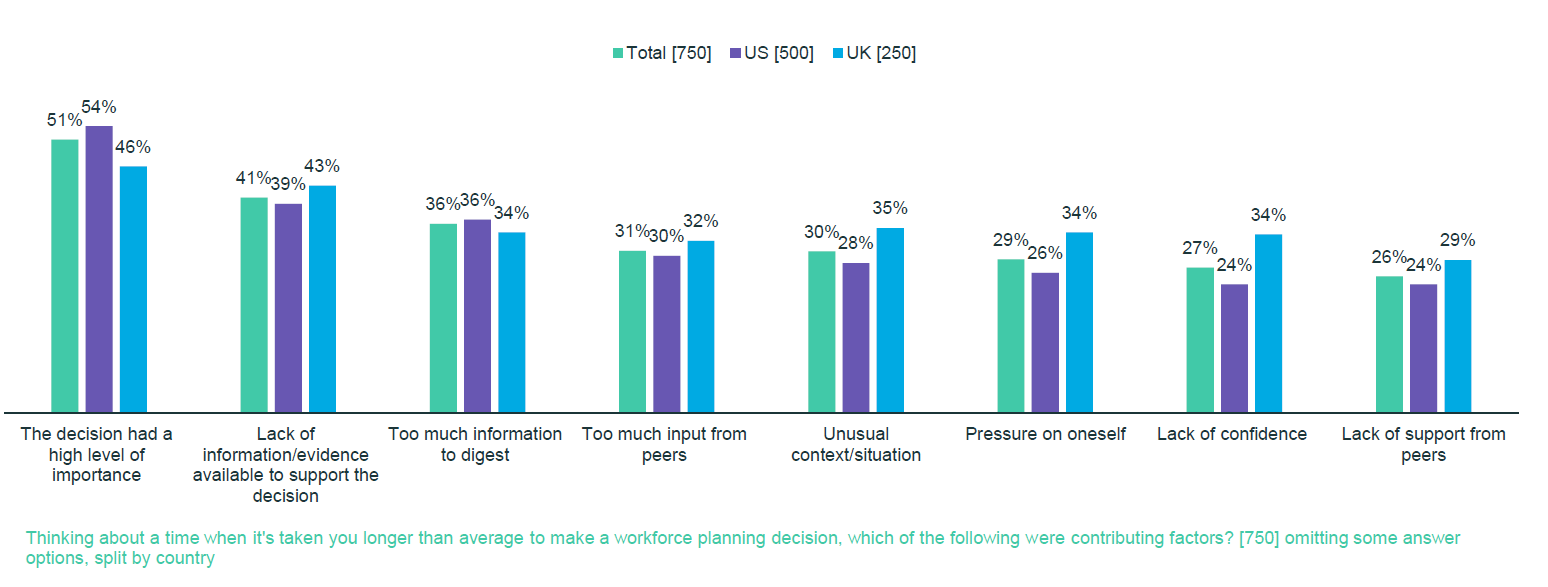Organizations need to take control
We surveyed 750 senior business leaders in the US and UK to find out what factors influence organizational decision-making and how that correlates to better business performance.
Published by Orgvue
Home > Resources > article > Organizations need to take control
Decision making is part of our everyday life, especially as leaders in business. So, what can we do to understand more about what goes into making a good decision? What’s the magic equation that means we can get it right every time, particularly in the game-changing organizational decisions that leaders make daily?
We partnered with market research specialists Vanson Bourne to poll 750 senior business leaders in the US and UK to find out the factors that influence organizational decision-making and how that correlates to better business performance.
The results
In a nutshell, and perhaps unsurprisingly, businesses that take longer to make organizational decisions are losing out.
According to our Time to Decision research, organizations with access to the right data make decisions addressing inefficiency and ineffectiveness 30% faster than those who don’t. Those same organizations also see 16% higher profits*, meaning those who don’t have access to the right information are likely to be leaving cash on the table.
But with 55% of business leaders reporting they have stuttered when making an organizational decision in the last year, what exactly is stopping them from taking decisive action, faster?
What is slowing down the time to decision?
Without a doubt, the unpredictability of 2020 has had an impact, with almost all (97%) of the surveyed leaders stating that the workforce decisions they’re making now are more important than ever. With more at stake, leaders need more time to reach a decision.
Data also plays a vital role. Either there’s not enough to support decision making or, conversely, there can be too much information to digest. Both factors slow down progress and leads us to seek a ‘Goldilocks’ zone’ of just the right amount of evidence that can guide decision making.

Overall, confidence levels have been knocked by the global pandemic and the research uncovered several reasons why, ranging from there are more factors to consider in light of the pandemic (60%) to never having planned for a scenario like it before so it’s unchartered territory (51%).
There will be little respite from the uncertainty of 2020 as we move into 2021 with a new Administration in the US and Brexit for the UK on the horizon. Organizations will continue to be put under pressure to make more time-critical decisions with increasing frequency.
The key to rebuilding the lost confidence among leaders lies with data. The research shows that businesses with access to the right information make faster decisions in almost all scenarios: from planning the (re)deployment of their workforce, to addressing organizational inefficiency and ineffectiveness, to responding quickly to the needs of their customer base.
‘Time to Decision’ as a key success metric
So, what’s next?
According to 92% of the respondents, time to decision will be a key success metric for businesses moving forward. Especially as 89% believe that organizations that take too long to make decisions will risk getting left behind.
As our CEO, Rupert Morrison commented, “Too many businesses are still finding themselves hesitating in the hope that a silver bullet solution presents itself for the organizational challenges they’re currently facing. They’re asking themselves ‘what now?’ when the real question they should be asking is ‘what if?’. While COVID has caused unprecedented disruption for businesses globally in 2020, it’s not the first time a crisis has thrown us into uncharted territory, and it won’t be the last.
Our research is clear, leadership by instinct under these circumstances is a one-way ticket to slow decision making and could mean leaving cash on the table. Instead, invest in getting the right data to the right people and continuously model different scenarios. By doing so, you can make swift decisions fearlessly and we’ve seen how those organizations prepared to commit quickly and confidently to a course of action are seeing a greater chunk of revenue turn to profit.”
*profit as a proportion of total revenue
Read next…
Given game-changing decisions are needed almost daily for your business in these very disruptive times, find out more about how you can get organizational decision-making right every time. Read our most popular eBook: “Meeting constant disruption with constant design.”
Read next…
Ebook
Given game-changing decisions are needed almost daily for your business in these very disruptive times, find out more about how you can get organizational decision-making right every time. Read our most popular eBook “Meeting constant disruption with constant design”
Press release
Press release announcing new research report.